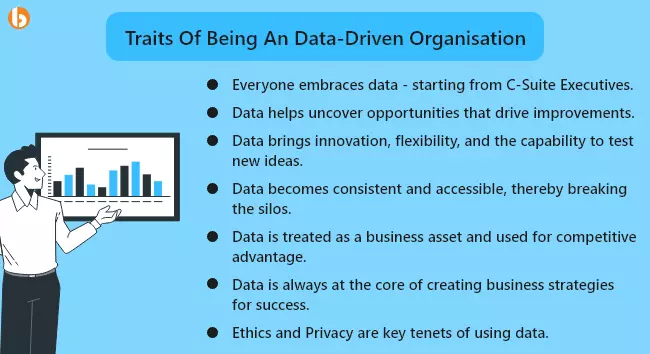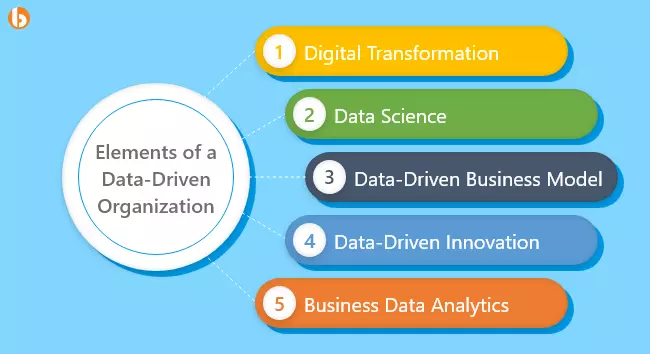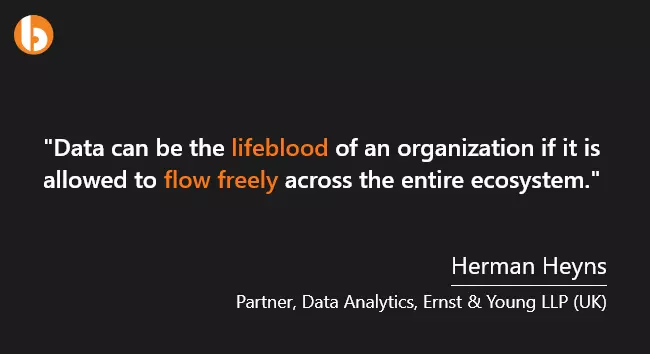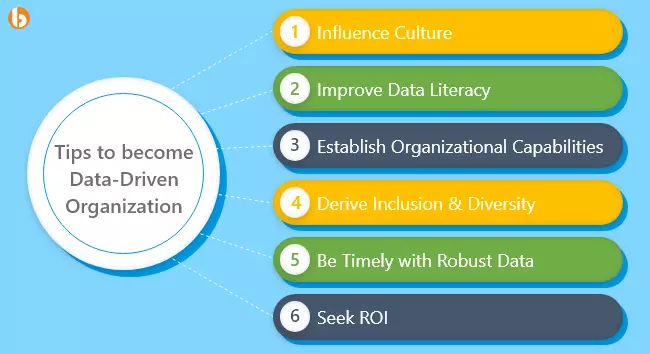Quick Summary:
This blog helps you understand what a data-driven organization is and how to build one by keeping business data analytics at the core. The blog covers a few key elements of a data driven organization and allows you to review if your organization has a data-first approach or if you need to adopt one.
Table of Contents
Introduction
As we are becoming increasingly digitized, the amount of data generated by people, machines, organizations, governments, and things is enormous. At this point, it is clear that data is the new oil. Everyone is racing to build a data-driven organization to make the most out of data.
What Does It Mean To Be a Data-Driven Organization?
Having data infrastructure or experts on board does not mean you are a data-driven organization. If you want to become a data-driven company, data has to run through your veins and be ingrained in your organization’s DNA.
If you doubt whether your organization is data-driven or not, here is a checklist that simplifies the traits of being a non-data-driven organization,
🟠 Your objectives are unrealistic, and results are limited to specific teams.
🟠 Immobilized data entrapped in apps and spreadsheets.
🟠 Inconsistent reporting of core metrics without apportioned definitions.
🟠 Not including goals, milestones, and success KPIs in new project plans.
🟠 Ad-hoc reporting and that too is used rarely.
If you think generating many reports or having multiple dashboards means being a data driven organization, you are hugely mistaken. These are all activities an organization does on a day-to-day basis and are typically backward-looking. It is like a politician promising a better future without a great deal of context, without a plan of action, and without recommending what role you would play. Let’s say this is an authoritarian lie with no base or limits.
Consider a more futuristic analysis, like predictive models giving information on ad spending, customer churn, supply chain replenishment, etc. These analytics answer more generally the “w-questions”: who, what, when, why, and where. Altogether, making recommendations, telling a story, and presenting findings. These questions are critical drivers of a data-driven organization. If you act upon those recommendations, you unlock excellent growth potential.
Building a data-driven organization is not binary but rather a continuum.

Key Elements of a Data-Driven Organization
Data-driven and data-driven decision-making are the next big things to succeed in business. Organizations realize it is not just enough to collect raw data; adopting innovative business data analytics strategies for better decision-making is equally important. Companies understood the value of data and focused their efforts on building data-driven organizations.
If you are willing to transform your company into a data-driven organization, here are the five key elements you must focus on.

Digital Transformation
Most organizations have already adopted it, and the remaining are on the verge of attaining digital transformation. A digitized organization with a clear vision and futuristic goals is pivotal in integrating data into existing and new processes.
Adopting an open and innovative digital transformation culture that enables product and service innovation significantly impacts the dream of building a data-driven organization. A digital infrastructure creates a data awareness culture and allows seamless interaction between people, processes, and customers.
Data Science
Due to technological evolution, the way people interact with innovative technological tools and platforms has changed. New technologies and devices have significantly transformed how data is created, consumed, shared, and used. Data science is an innovative approach to analyzing and gaining value from data. By turning data science prototypes into real-life models, data processing, integration, and analysis can produce beneficial, insightful, and productive results.
Having Data scientists in the team can add value in many ways to build a data-driven organization – offering transparency, identifying needs, discovering the target markets, personalized marketing, supporting decision-making, and innovating new business models, products, and services.
Data-Driven Business Model
After transferring the derived insights into active business models, you can create economic value. If you are willing to develop a data-driven business model, you must move forward strategically:
1. It would be best if you found the market demand.
2. You must develop a business model by discovering, creating, and realizing value.
3. Refine the business models until it suits your expectations.
The critical part is value creation – and a data-driven business model explicitly focuses on data and treats it as a key asset. However, to treat data as an asset, you must focus on the dynamic capabilities of your business; then integrate processes to explore and exploit the data resources, making it easier to measure and identify value.
Data-Driven Innovation
The majority of organizations use their data to transform businesses into data-driven innovations. We call this data Big Data, characterized by Volume, Variety, Velocity, and Veracity. Therefore, to use this data, a data-driven organization has to analyze and discover data, predict and optimize it through cutting-edge algorithms, and distribute insightful information across departments.
To foster a data-driven organization:
🟠 Identify the type of data that needs to be collected and its sources.
🟠 Determine the best way to process and transfer data to storage.
🟠 The best way to analyze the data.
Business Data Analytics
Every organization wants to gain information from collected data to establish a data-driven business model or achieve data-driven innovation. Business data analytics thus create value, but businesses must consider their goals while adopting the data analytics strategy. A clear understanding of data, information, and knowledge makes adopting the precise data analytics model easier.
Business data analytics helps organizations to gain critical business insights. Besides, data analytics is classified into – descriptive, predictive, and prescriptive analytics. Descriptive analytics informs you about past happenings. Predictive analytics forecasts future events using predictive, clustering, and association models. In contrast, prescriptive analytics is used to understand the business better, like sales, marketing, objective functions, etc.

Invest in Business Data Analytics To Become Data-Driven Organization
In a digitally transformed organization, every action is a data footprint. With increasing data, the digital universe is racing with the physical universe in size and complexity. As per the data storage vendor EMC, the digital bits of data created by humans will soon be as big as stars in the universe. As data creation reaches 44 zettabytes annually, harnessing all this data is a daunting and intimidating proposition.
However, organizations need to adopt an analytics-driven culture to outperform data creation by fostering a data-driven organization. Business data analytics is essential to drive value through data. Remember for data analytics, data always has to be clean otherwise it is just noise.
Data Analytics Streamlines the Data Journey
It would be best if you had the correct data strategy to handle data. The best approach is to collectively look at all the aspects of data and focus on implementing an individual point solution for addressing key challenges.
Data and analytics are directly related. Without data, your business would be unable to make decisions or act. Thus harnessing the importance of data increases the depth of data analytics. Since data is progressing towards colossal status, start using ingenious data collection methods. More intelligent data helps you derive historical and predictive insights necessary to make wise decisions.
If you want to become a data-driven organization, having a strong data foundation matters a lot. It helps you to progress to the next stage, i.e., obtaining actionable insights by running appropriate business data analytics.
Every Piece Of Data is Valued
To ensure that they have the right strategies and workable processes to collect data, a data-driven organization must deploy a comprehensive data policy that covers critical data sources, data capturing channels, data storage, and data management architecture.
Every business willing to become a data-driven organization must understand that this is an ongoing process. It has to be monitored, reviewed, and enhanced continuously. It helps align your data strategy with the business goals, evolving trends, technologies, and changing market conditions.
However, it is not all; businesses need to collect, store, process, and cleanse the data by removing noise. Structured, validated, and clean data is necessary to derive value.
This value is again classified into three categories,
🟠 Information – That conveys what you have already done, achieved, or accomplished.
🟠 Knowledge – The insights derived from the data give answers to why something happened or what will be the future outcomes.
🟠 Wisdom – It uses historical data to inform future happenings and actions.
Profound Business Data Analytics For Better Outcomes
Embarking on a business data analytics journey is a challenging task to succeed. One of the primary reasons why many organizations fail to deploy the right data analytics strategy is a need for more management support. To become a data-driven organization, you must embrace an analytics-driven culture, which requires a cultural shift involving focus and strategy.
The CEO, CDO (Chief Data Officer), and other C-level managers must create a roadmap and undertake efforts to bring analytics culture into the organization’s DNA. Ensuring everything is aligned, including business vision, evolving technology, and changing market trends, and by automating internal and external processes, you can build a data-driven organization that has a full-fledged data analytics strategy at its core.
Now the question is what kind of profound business data analytics is possible that leverages modern technology and tools. Well, here are the data analytics techniques that you can integrate into your business,
🟠 Descriptive – Standard reporting that provides insights into what has already happened in a specific campaign or a business process.
🟠 Diagnostic – Informed reporting that conveys what actually happened and whether it was good or bad.
🟠 Predictive – Analytics models leveraging statistics, AI, and ML algorithms for a better understanding of what happened in the past for better predicting future outcomes.
🟠 Prescriptive – It is a paradigm in data analytics that determines the best possible approach or method for future action by synthesizing data, business, and analytics.

How Does Bacancy Help?
In today’s digital world, data plays a crucial role. Bacancy is one of the best data science consulting firms, known for helping clients create a strategic roadmap for harnessing data and implementing a data-first culture in their organization. If you are looking to boost your efforts in building a data-driven organization, we can be a one-stop solution for you!
Our data strategy covers both near-term data use cases that impact business productivity and revenues and makes you understand the long-term impact of data on your business model.
Bacancy helps you achieve a disruptive transformation by putting data and digital at the forefront. We will act as librarians who intend to build a solid data foundation. You can rely on Bacancy for all your data needs, whether related to data science, business data analytics, or making a data-driven organization.
Frequently Asked Questions (FAQs)
To become a data-driven organization, you need rightful involvement from C-level managers, and only a few organizations have a dedicated CDO (Chief Data Officer) position.
Implementing a culture change is the primary objective of being a data-driven organization. Adopting data-first culture is very much essential to make the cultural shift.
Failure to take ownership and manage the huge amount of data.
Practicing ethical data usage and using comprehensive data security, governance, and compliance policies is still a significant issue.
There is a stepwise approach to creating a data-driven organization,
🟠 Create and nurture a culture where data-driven decision-making is pivotal.
🟠 Prioritize to build an organization-wide business data analytics proficiency.
🟠 Strategize and govern data access and also build user confidence.
🟠 Start implementing the data culture right from above.
🟠 Offer specialized training to employees and people to use data and make data-driven decisions.
🟠 Use analytic insights to make decisions and achieve growth.
🟠 Data literacy
🟠 Data Ownership
🟠 Data Leadership
🟠 Data Democratization
🟠 Automation
🟠 Data-First Culture
🟠 Data-Driven Decision Making
🟠 Data-Driven Innovation
Your Success Is Guaranteed !
We accelerate the release of digital product and guaranteed their success
We Use Slack, Jira & GitHub for Accurate Deployment and Effective Communication.




